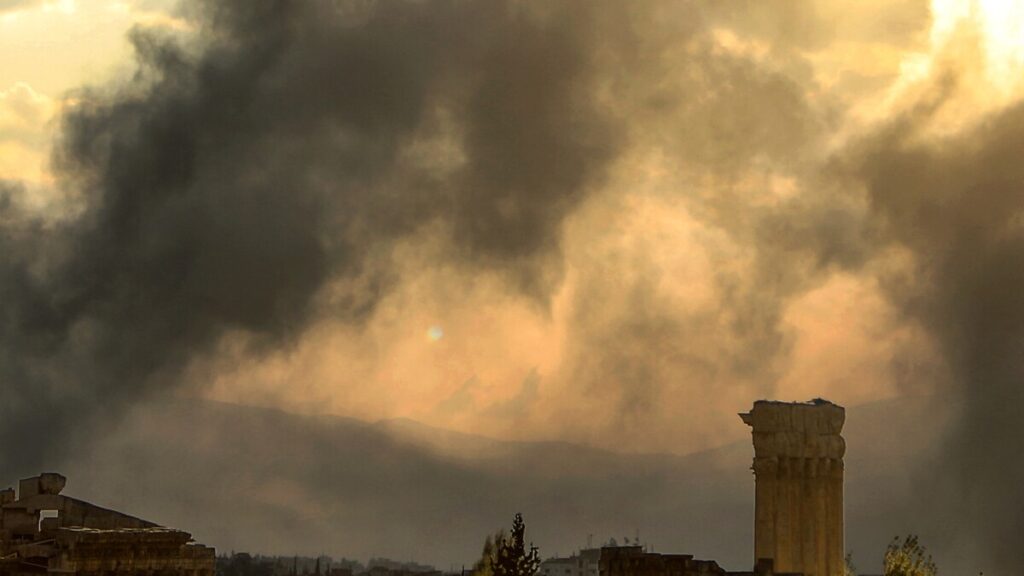Israel’s first city-wide forced displacement calls for Lebanon’s eastern city of Baalbek were followed by air attacks.
On October 29, 2024, people gathered to assess the aftermath of an overnight Israeli airstrike on the Gouraud Barracks neighborhood in Baalbek, Lebanon’s eastern city. The area, situated near the ancient Roman ruins of Heliopolis, suffered significant damage. [Nidal Solh/AFP]
This week, Israel issued a citywide evacuation order for the first time since intensifying its attacks on Lebanon in late September. Tens of thousands have fled Baalbek, the largest city in eastern Lebanon, in response to Israeli directives for displacement in the city and its surrounding villages.
On Wednesday and Thursday, Israel issued orders indicating it was preparing to strike targets associated with the Lebanese group Hezbollah, followed by actual strikes on Baalbek. The initial displacement order on Wednesday sparked widespread alarm. “People are panicking, running around in confusion, bumping into each other, unsure where to go or what to do,” said Roula Zeaiter, program manager for RDFL (The Lebanese Women Democratic Gathering), describing how crowded neighborhoods—many sheltering families displaced by Israeli bombardment in southern Lebanon and nearby areas—emptied rapidly.
“Minutes after the evacuation order was issued, the streets filled with people hastily gathering belongings, locking their doors, and shutting down shops,” Zeaiter told ActionAid, RDFL’s partner organization. “We’re scrambling like frightened mice, moving from place to place. Lebanon is starting to feel like Gaza, with Israeli forces employing the same tactics.”
Just hours after Wednesday’s evacuation order, airstrikes hit Baalbek and its surrounding areas, confirmed Mayor Mustafa al-Shall. The Lebanese Ministry of Public Health reported 19 casualties, including eight women.
What is Baalbek known for?
Home to around 80,000 people, Baalbek overlooks the Bekaa Valley in eastern Lebanon. It is considered a key part of Hezbollah’s stronghold in the region.
Baalbek is believed to be an ancient Phoenician city and is renowned for housing some of the best-preserved Roman ruins in the world, including the Temple of Bacchus. In 1984, it was designated a UNESCO World Heritage Site for its remarkable ancient Roman temple complex, which UNESCO describes as “one of the finest examples of Imperial Roman architecture at its apogee.” These historical sites attract tourists from across the globe.
Tourism is a vital source of support for the local population, along with agriculture and traditional crafts such as rug-making and copperwork. As Israel intensifies its targeting of Baalbek, some residents are taking shelter in the temples, hoping that the ruins’ cultural heritage status will provide them with some level of protection, according to NPR.
Why is Israel targeting Baalbek?
The Israeli military states that Hezbollah has military installations within the city.

Translation:
#عاجل
Urgent Warning to the Residents of Baalbek, Ain Bourday, and Douris
🔸 You are in a combat zone where the IDF (Israeli Defense Forces) intends to attack and target Hezbollah infrastructure, interests, installations, and combat capabilities, and it does not intend to harm you.
🔸 Remaining in the red zone puts you and your family at risk.
🔸 For your safety, we urge you to evacuate your homes immediately and leave these areas using the following routes:
‼️ Zahle – Baalbek Highway
‼️ Nahle – Baalbek Road
‼️ Cedar Road – Baalbek
“Earlier today, the air force struck command and control centers and terrorist infrastructure used by the Hezbollah terrorist organization in the areas of Baalbek, deep in Lebanon, and Nabatieh in southern Lebanon,” the Israeli military stated in a press release on Thursday.
Has Israel always issued evacuation orders during its assault on Lebanon?
No.
On Tuesday, before the residents of Baalbek were ordered to evacuate, Israel targeted several towns in the Bekaa Valley, resulting in 60 fatalities. None of these towns received any prior warning.
While Israel asserts that it is targeting Hezbollah, residents of the affected towns, along with Lebanese officials and human rights organizations, contend that the airstrikes are indiscriminate. There have been multiple instances of Israel striking civilian targets without prior warning.
Earlier this week, an airstrike on Haret Saida in Sidon, southern Lebanon, resulted in the deaths of five people and injuries to 33 others. A local resident informed the AP that the victims were civilians. In mid-October, an unannounced strike on the predominantly Christian village of Aitou in northern Lebanon killed 21 people and injured eight, hitting a house rented by displaced families; residents reported no prior warning.
About a week later, 13 individuals, including a child, were killed in an Israeli attack near the Rafik Hariri University Hospital, Lebanon’s largest public health facility in Beirut. While warnings were issued prior to heavy strikes in the southern suburbs, the assault near the hospital occurred without any warning.
Israel and Hezbollah began exchanging cross-border attacks a day after the war in Gaza commenced on October 7, 2023. Hezbollah asserted that it was supporting Gaza and pressuring Israel for a ceasefire. Subsequently, in late September, Israel escalated its assault on Lebanon.
Since October 2023, at least 2,867 people have been killed and 13,047 wounded in Israeli attacks in Lebanon, according to the Lebanese Health Ministry. In the past 24 hours alone, 45 people have died across the country, and more than 188,000 individuals have been displaced during this period.
